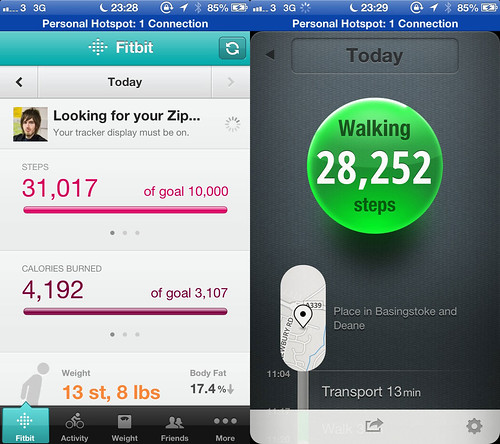I’ve got about twenty posts I want to make, but this one’s timely and short so it’s going up first!
I’ve been evaluating a FitBit Zip for the past four months, and I’m pretty happy with it- a few days ago I was told about the “moves” application for the iPhone, since then I’ve been using the two alongside each other.
I had quite a long journey today, so I decided to take this opportunity to post a quick comparison between the two tracking systems, as shown in the following screenshot:
(also, this is the first time I’ve broken 30,000 steps in one day on the Fitbit- pretty pleased with that!)
Now, those numbers are impressively similar (especially considering the Fitbit uses additional hardware- a posh £50 Bluetooth 4 accelerometer and Moves mostly relies upon GPS), and whats more impressive is the additional information moves provides- there’s a list of the places I’ve visited, a breakdown of the different transport methods (walking, running, bicycle and, for now, “other”) and a breadcrumb trail of my route. In my testing so far I’ve found there to be very little effect on the battery life of my phone too, which is a relief as it’s rather awful already (I must go and see Apple about that)!
There are, of course, a couple of limitations. The application needs to be running all the time, which obviously does have some effect on battery life. It also of course only tracks activity when you’ve got the phone on you, and now when you’ve left it charging on your desk… and it doesn’t count activity that consists of less than 50 steps. This probably accounts for the difference between the two counts, and in my opinion makes the lack of discrepancy between the two all the more impressive.
As you can probably tell, I’m very impressed, and especially so for a fairly early iteration of the application (it was originally released in September and has had a number of fairly small updates since). Whilst it currently misses most of the encouragement and intervention techniques offered by the Fitbit and alternatives it also offers additional functionality missing from all of these, and best of all, it’s free!
As my particular research interest is more in sustainable transport methods than physical activity I’m especially interested in Moves. I’m sure that motivational techniques will be added soon, the developers have also stated that there’s an API coming, so I’m watching very closely to see how I might be able to make use of this in my PhD research.

would you recommend Move over FitBit
Hi Gerry, what are your goals?
I think that at this moment the Fitbit is a better bet- Moves does a fantastic job of detecting activity without the need for any additional hardware, however this comes at the expense of battery life. I’m a big fan of the fact that Moves can reliably track cycling, walking running and other methods of transport and display your routes on a map- for informing transport choices and general reflection I think this is brilliant!
I visited Paris for CHI a few weeks ago and I really wish I’d had moves running so I could see where we went… Unfortunately the battery life impact prevented me from doing this as I needed to have some charge in my phone in case of emergency (I’m not so worried about this in London & I always have my laptop in my bag for any emergency charging).
Moves also doesn’t offer you access to your step data, there’s no easy way to review your previous activity/ trends, other than scrolling back through each previous day. Fitbit also offer you a number of other things which may encourage people to do more activity- badges, goals, social influence, etc.
So, as an intervention to encourage a behaviour change I think the fitbit is best at the moment, but this is in no way to discourage what Moves have done for so far. If it wasnt for the battey life issue I’d use both every day. However, the near-distant future is likely to bring quite a lot of progress in these types of device and application for tracking physical activity. Other types of sensor (such as temperature, galvanic skin response, heart rate variance and even EEG) are beginning to be integrated into these types of devices, giving users a plethora of extra information. One of the big challenges (and something I’m very interested in researching) is how people can make sense of this extra data and if it’s actually useful in encouraging behaviour change. I suspect the novelty effect of a new piece of hardware will be even greater if the user is only given raw (or nearly raw) data output, which can be difficult to understand and spot trends. It needs to be something the user is interested in seeing and can actually make sense of, giving some insight. At the same time I also think its very important that we SHOULD have access to the raw data if we so wish, I’m not a fan of the systems which offer only an abstract view of your collected data and then don’t allow access to what’s been collected… It’s our own data after all and we should have access to it!
I think we’re also going to begin seeing quite a lot of progress in the mobile applications using phone sensor data, things like Google Now could potentially integrate nice interventions to travel more sustainably or engage in physical activity throughout the day.
Danny